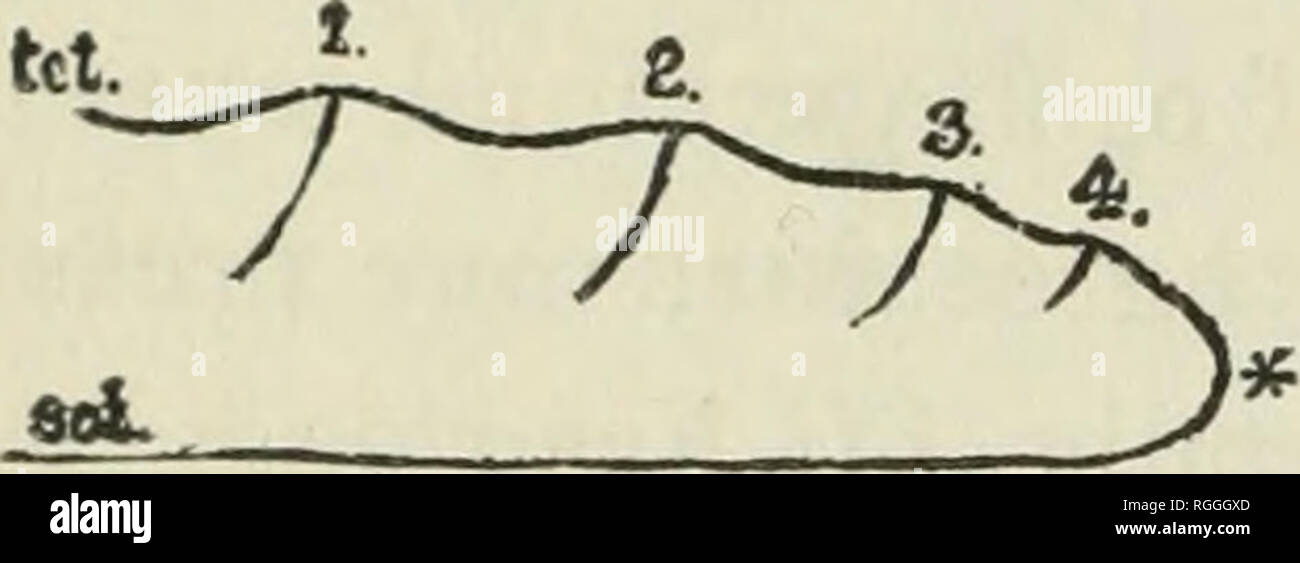. Bulletin of the Museum of Comparative Zoology at Harvard College. Zoology; Zoology. 122 BULLETIN OF THE instead of one. Reichert ('69, p. 311, Fig. 28, Plate VI.) has shown that in Zoobotryon (one of the Ctenostomata) "an der Mantelflache, und zwar einseitig, inseriren die Bryozoenkbpfe mit Alternation in par- allelen, wie es schemt, langgezogenen spiralig verlaufenden Reihen an- geordnet." Nitsche (75, p. 370) states that the buds in Loxosoma arise from the mother alternately on opposite sides, and that the younger the bud, the nearer it is to the foot of the parent individual. Bo

Image details
Contributor:
Book Worm / Alamy Stock PhotoImage ID:
RGGGXDFile size:
7.1 MB (122.1 KB Compressed download)Releases:
Model - no | Property - noDo I need a release?Dimensions:
2618 x 954 px | 22.2 x 8.1 cm | 8.7 x 3.2 inches | 300dpiMore information:
This image is a public domain image, which means either that copyright has expired in the image or the copyright holder has waived their copyright. Alamy charges you a fee for access to the high resolution copy of the image.
This image could have imperfections as it’s either historical or reportage.
. Bulletin of the Museum of Comparative Zoology at Harvard College. Zoology; Zoology. 122 BULLETIN OF THE instead of one. Reichert ('69, p. 311, Fig. 28, Plate VI.) has shown that in Zoobotryon (one of the Ctenostomata) "an der Mantelflache, und zwar einseitig, inseriren die Bryozoenkbpfe mit Alternation in par- allelen, wie es schemt, langgezogenen spiralig verlaufenden Reihen an- geordnet." Nitsche (75, p. 370) states that the buds in Loxosoma arise from the mother alternately on opposite sides, and that the younger the bud, the nearer it is to the foot of the parent individual. Both Hatscheck (77, pp. 517, 518, Fig. 33, Plate XXIX.) and Seeli- ger ('89, p. 176) show that in Pedicellina young individuals are devel- oped in the plane of the older ones, and are successively formed at the growing tip of the stolon, towards which the oesophageal side of all individuals is turned. This relation is the same as that which we have found in Cristatella. In Cheilostomata, however, it is apparently the anus which is turned towards the budding margin. Thus, throughout the group of Bryozoa, we find that the position which young buds assume in relation to older individuals is very definite. I am inclined to believe that the radial partitions of Cristatella sep- arate the morphological equivalents of the isolated branches of such a form as Plumatella punctata (see Kraepelin, '87, Taf. V. Figs. 124, 125). The type of budding which gives rise to the series of median buds may, then, be represented, as seen from the side, by Figure B. The margin (*) will then represent that portion of the body-wall of the youngest individual, which will give rise to a part of Figure B. the body-wall of the next younger individual. The process by which the body-wall of the individual of Cristatella is formed is therefore, in my opinion, different from that which Braem describes in the case of Alcyonella, for he maintains that in Alcyonella the proper body-wall of an individual arises later